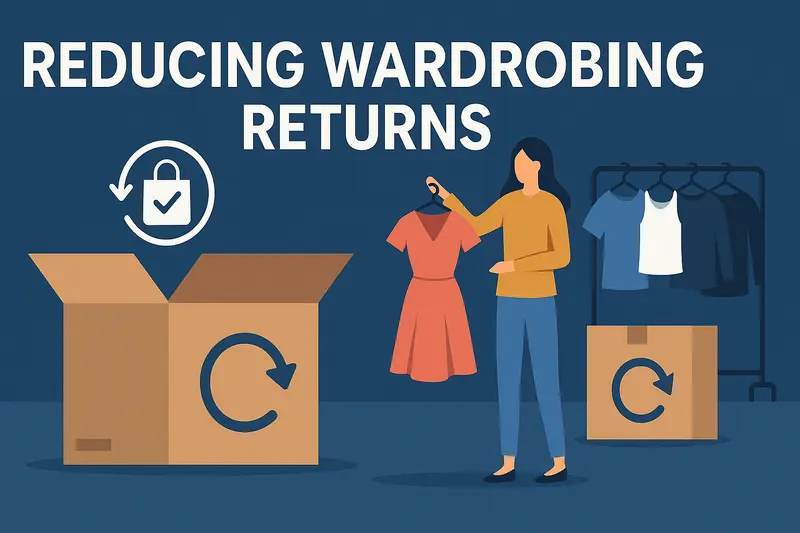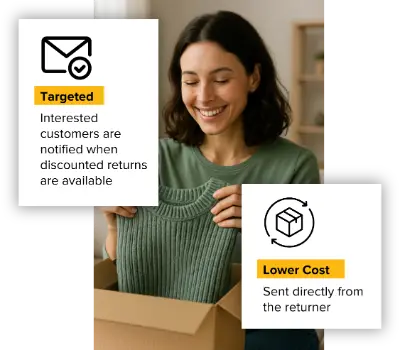Combating Wardrobing: Safeguarding Your Business from Ecommerce Returns Fraud

Last updated on October 02, 2025

What is Wardrobing and Return Fraud?
“Wardrobing” is a type of return fraud that’s all too familiar to apparel and fashion retailers. It refers to customers who purchase an item, often clothing or accessories, use it briefly, and then return it for a full refund as if it were new. Essentially, they’re treating your store like a free rental service for their wardrobe. For example, someone might buy an expensive dress for a wedding, wear it once to the event with the tags tucked in, and then send it back claiming “it didn’t fit” or some other excuse. The term comes from the idea of “borrowing from the wardrobe” and returning, or as some call it, “free renting.”
Another common type of return fraud is price switching, where a cheaper item is returned instead of a more expensive one to exploit retailer return policies. Friendly fraud, where customers claim refunds for items they never received (but did) or return used items as new, is also a growing concern.
This practice is a form of first-party fraud, meaning it’s the actual customer (not an identity thief or someone who stole a credit card) engaging in the deceit. They have intent from the start to get their money back after using the product. Wardrobing isn’t limited to clothes; people have been known to “wardrobe” things like high-end cameras or tools (using them for a project and returning), but apparel is where it’s most rampant and where the nickname comes from. Return processes can be exploited for wardrobing, as customers manipulate these policies to their advantage.
How big of a deal is wardrobing? Unfortunately, pretty big. A study in late 2024 found that over two-thirds of shoppers admitted to wardrobing an item at least once. That statistic is startling, it suggests this behavior is moving toward the mainstream. What’s more, most of those who do it say they engage in wardrobing at least once a month! So it’s not just a one-time thing; there’s a chunk of customers regularly using retailers as a temporary closet. Reasons vary, but many do it for financial reasons (76% said they wardrobe to save money or because they only needed the item once). Essentially, if they can get the benefit of the product without paying (by returning it), some will take advantage.
Make Returns Profitable, Yes!
Cut shipping and processing costs by 70% with our patented peer-to-peer returns solution. 4x faster than traditional returns.
See How It WorksFor retailers, wardrobing is a nightmare. You’re left with used merchandise that often cannot be sold as new, meaning you have to mark it down or dispose of it, pure margin loss. It’s estimated that overall return fraud (including wardrobing and other scams) made up about 10-15% of returns in recent years, costing U.S. retailers on the order of $100 billion in 2024. Return fraud refers to efforts by individuals to exploit a retailer’s return policy for personal gain. Wardrobing is frequently cited as one of the biggest contributors to those fraudulent returns. Beyond the direct financial loss, it’s also frustrating for merchants because it abuses the goodwill of flexible return policies intended for honest customers.
Understanding wardrobing is the first step in combating it. Recognize that when you sell high-end apparel, electronics, or other easily “borrowed” items, a subset of customers might attempt this ploy. Awareness allows you to put safeguards in place. It’s a fine line, you want to accommodate genuine returns (someone who truly found the dress didn’t fit, unworn, should be able to return), but you need to deter and detect those who are gaming the system. The following sections cover how to spot wardrobers through analytics, and policy and operational measures to reduce this kind of fraud.
Behavioral Analytics
One of your best weapons against wardrobing is data, specifically, advanced tools and behavioral analytics that can detect fraud patterns and suspicious activities. Much like credit card companies use algorithms to detect fraudulent purchases, retailers can use analytics to detect likely fraudulent returns.
Start by tracking customer return behaviors at the individual level. Tracking customer return behaviors can help identify suspicious activities that may indicate fraudulent returns. For example, what percentage of a given customer’s purchases are returned? How frequently do they initiate returns, and do those returns often cluster right after weekends or events (a red flag for wardrobing)? A customer who buys an expensive outfit every Friday and returns it every Monday is pretty clearly up to wardrobing. Modern ecommerce platforms and returns management systems allow you to aggregate this data. If not, even basic analysis exporting transaction data to Excel can surface extreme cases.
Behavioral analytics can encompass various signals:
- Return Rate per Customer: If a customer has a return rate significantly higher than average (say they return 80% of items purchased, when the norm is 20%), that’s a candidate for scrutiny.
- Usage Signs: Some retailers require noting the condition of returned items. If you can capture or categorize that (e.g., “appears worn” vs “unopened”), then any customer repeatedly returning “worn” items is a red flag.
- Timing Patterns: As mentioned, look at timing. Wardrobers often buy right before they need an item and return right after. If someone consistently keeps items just for a short period (especially matching common use cases like weekends, holidays, or specific events), analytics can catch that pattern.
- Category-Specific Signals: If a customer only ever returns certain item types that are prone to wardrobing (like high-end dresses, luxury handbags), and keeps other things, it might indicate they exploit certain categories.
Using these data points, you can employ an AI or machine learning model to predict fraudulent return probability. Some retail fraud solutions (by companies like Signifyd, Forter, or Returnalyze) actually score returns and customers on risk. They ingest historical return data and learn what combinations of factors correlate with wardrobing or fraud. For instance, machine learning algorithms can identify “customers with a high return %, often on expensive items, and frequently cites ‘didn’t need’ as the reason,” and flag them as a risky profile.
With behavioral analytics, you don’t necessarily have to outright ban customers (that can be a last resort). You can start by segmenting them. For example, flag high-risk returners in your CRM. Then perhaps your system can enforce extra checks or stricter rules for them (like no free return shipping, or manual approval needed). Some retailers quietly maintain “watch lists” of serial returners. Even Amazon famously will ban users who abuse returns too much, and they determine that via data analysis of return patterns.
To illustrate, imagine Customer A has bought 10 evening dresses in the last 6 months and returned 9 of them, each time after a weekend. Your analytics could automatically mark Customer A as a potential wardrober. Next time they try to return, you might require an inspection or deny the return if it violates policy (assuming you have grounds, like signs of wear).
Behavioral analytics can also feed into fraud prevention algorithms that operate in real-time. For instance, at the point of return initiation on your website, if the system knows this customer’s history is problematic, it could respond differently (maybe saying “This item is final sale” if that’s enforceable, or simply flag internally for review).
Make Returns Profitable, Yes!
Cut shipping and processing costs by 70% with our patented peer-to-peer returns solution. 4x faster than traditional returns.
See How It WorksIn sum, leveraging data to monitor and analyze return behavior helps you separate the honest customers from the abusers. It’s a proactive approach; catching patterns early can save significant losses. It also allows you to tighten up on the small percentage of bad actors while still offering leniency to your good customers (who shouldn’t be punished for others’ fraud).
Smart Return Policies
Your refund policy is one of the most direct ways to prevent return fraud and combat wardrobing. A well-defined returns policy can help mitigate returns fraud and abusive return behaviors. By crafting “smart” policies, you create rules that deter fraudulent returns without unduly burdening legitimate customers. Here are some policy tactics:
- Shorten the Return Window for At-Risk Products: Wardrobers usually want to use the item for a specific event, then return it. If your return window is 60-90 days, it’s easy for them to wait and return. But if it’s, say, 14 days for special occasion apparel, you limit the opportunity. Many fashion retailers have moved to a 14 or 30-day window, which puts pressure on wardrobers, as they can’t wait too long (like after the wedding season) to return. You might keep a longer window for less fraud-prone categories and a shorter one for high-end fashion. Just be sure to communicate it clearly on the product page (e.g., “This item has a 14-day return policy”).
- “Wardrobing” Tags or Seals: Implement the use of special return tags on expensive clothing. This could be a large tag or sticker placed in a conspicuous area that doesn’t affect trying on, but would be very visible if you wore it out. The policy then states the item is only returnable if this tag is still attached. This physically prevents someone from comfortably wearing the item publicly, unless they’re okay with a giant tag showing (which defeats the purpose for them). Many formal dress retailers do this now. It’s a simple yet effective deterrent, honest customers don’t mind because they plan to remove the tag only when they’re sure they’ll keep it, and wardrobers are thwarted.
- Restocking Fees for “Rental-like” Returns: While restocking fees can be controversial, applying them in specific cases can dissuade wardrobing. For example, you could have a policy that if certain items (like high-end electronics or designer wear) are returned and show signs of use, a restocking fee of, say, 10-20% will be deducted. Knowing they won’t get a full refund might make a would-be wardrober think twice. However, be cautious, you need to enforce it consistently, and it might lead to some customer service tussles (“I only wore it once, why a fee?”). Ensure your policy explicitly mentions that returned items must be in new, unused condition for a full refund, or else a fee applies. Over half of retailers are considering adding fees if they haven’t already, largely to combat the cost of these abuses. Refund abuse is a significant issue, and rigorous guidelines can help prevent such practices.
- No Returns on Certain Items: An extreme but sometimes necessary measure, label some items as final sale or no-return. Lingerie or swimwear is often non-returnable due to hygiene reasons, which incidentally also prevents wardrobing them. Some luxury fashion brands do not offer returns on haute couture pieces. If you identify a product line that’s heavily abused and not core to your business, you might cut off returns entirely. Of course, this can deter purchases too, so use it carefully. Alternatively, you could allow returns but only for store credit on those items, not cash back, which is less attractive to wardrobers.
- Limit Free Return Shipping: If you currently offer free returns for everything, consider modifying that. Perhaps make free returns a perk for loyal customers or for exchanges only. If a suspected wardrober knows they’ll have to pay $10 to send it back, the “free rental” isn’t entirely free anymore. According to industry surveys, some 55% of retailers who didn’t charge fees were considering implementing them, precisely to curb abuse. You could, for instance, still offer free returns on normal items but exclude certain categories (formal wear, electronics) from free return shipping unless defective.
- ID or Receipt Requirements: In physical retail, many stores require an ID for returns, which feeds into databases that track serial returners (The Retail Equation is an example service). Online, you obviously have the customer’s account info, but if you suspect someone might be exploiting by using multiple accounts, you could require proof of purchase or other verification. This is more on the fringe for ecommerce, but some companies cancel or deny returns if the order can’t be verified against an identity (to combat things like people returning stolen goods for credit, etc.).
In implementing smart policies, the key is to target the policy friction where the fraud happens, while keeping things smooth for honest customers. One approach is a tiered policy: your general policy stays friendly (because you don’t want to scare off regular shoppers, remember 87% of consumers would likely stop shopping with a brand that eliminated free returns entirely (PowerReviews)). But you have fine print or category-specific rules that address wardrobing scenarios. And importantly, train your customer service on these; they need to understand why those rules exist and how to explain them to customers.
Let AI Optimize Your Shipping and Boost Profits
Cahoot.ai software selects the best shipping option for every order—saving you time and money automatically. No Human Required.
See AI in ActionA smart policy might read, for example: “Returns are accepted within 30 days for a full refund. Items must be unworn, with original tags attached. Special occasion dresses must have the return tag intact to qualify for refund. We reserve the right to charge a 15% restocking fee on products that show signs of use.” This kind of language sets the stage to refuse a blatant wardrober return politely but firmly, while allowing legitimate returns. Additionally, implementing proactive measures such as digital tracking and advanced technologies can help identify and adapt to fraudulent patterns, ensuring a balanced approach to fraud prevention.
Warehouse Fraud Controls
Even with good policies and analytics, some wardrobing attempts will slip through to the returns stage. This is where your warehouse or returns center processes need to catch and respond to fraud. Essentially, when a returned item comes in, your team should be on the lookout for signs of wardrobing or other fraudulent activities and handle it according to your protocols.
Dishonest employees can also play a role in return fraud. They may collaborate with external parties to manipulate the return process and facilitate fraudulent returns.
Key controls and practices include:
- Thorough Inspection: Train your returns processing staff to carefully inspect high-risk returns. They shouldn’t just verify the item is in the box; they need to check for subtle signs of use. For clothing: look (and sniff!) for perfume, smoke, or sweat odors, makeup or deodorant stains, stretched fabric or creases in places that indicate wear, scuffed soles on shoes, etc. For electronics: check the device’s usage logs if available (some devices can show last used date or total run time), look for any user data left on it, check for scratches that indicate it was out of the box. Having a checklist for “what to inspect” per category helps maintain consistency.
- Photographic Evidence: It can be useful to take photos of items that are returned in unsellable condition due to use. This serves two purposes: documentation in case you need to prove to a customer why their refund was denied or partial (e.g., “you returned a dress with obvious wear; here are the photos we took as evidence”), and data collection for your internal use. Some retailers even take a photo of each return as it’s processed for records. With smartphones, this is not hard, though at scale it’s extra work, so you might reserve it for suspicious cases.
- Triage by Risk at Intake: If your analytics or RMA system flagged a particular return/customer as high risk, inform the warehouse team via the system. For instance, the return label or packing slip could have a note “FLAG, inspect carefully” or something. That way, the staff know to scrutinize that one extra hard. In such cases, you might require a manager’s sign-off before approving the refund. This ensures wardrobing doesn’t get a free pass due to an overworked junior associate missing something. Essentially, integrate the earlier “behavioral flags” into your returns processing workflow.
- Decision to Refuse or Charge: Empower your team with clear guidelines on what to do if they confirm a wardrobing case. Some companies will outright deny the refund and ship the item back to the customer (at the customer’s expense), citing policy violation. Others might issue a partial refund (deducting a restocking fee or amount for the damage). Whatever you choose, have it defined. For example, “If an apparel item is returned visibly worn or damaged not due to our error, we will not refund and will notify the customer that the return was not accepted.” You’ll need customer service to back the warehouse up on these decisions. It can get sensitive, because you might have an angry customer claiming they didn’t wear it. That’s where evidence and having the policy clearly on their order receipt helps. Fraudulent refunds are a significant concern, and having clear policies helps mitigate these issues.
- Tamper-evident Packaging: For products like electronics or accessories, using tamper-evident seals can help. If a customer returns a box and the seal is broken, you know it was opened/used. You can then verify contents to ensure they didn’t do a “parts swap” scam (some fraudsters will buy a new item, put their old defective item in the box, and return it). Warehouse staff should cross-check serial numbers or IMEI numbers for electronics to make sure the same unit that was shipped out is what came back. This prevents a classic fraud of returning a different, older item or a cheaper item.
- Logging and Blacklist: Keep an internal log of fraudulent returns. If you identify a wardrober, tag their account. If someone sends back a box of rocks instead of the item (yes it happens), definitely blacklist that individual. A centralized system to mark problem customers will prevent future sales to them or at least allow you to reject future returns. Industry data shows that more than three-quarters of retailers claim to have a returns abuse mitigation strategy in place, which often includes such internal tracking.
- Collaboration with Loss Prevention: Treat return fraud like shoplifting. Many retailers involve their Loss Prevention (LP) or fraud teams to analyze returns and even investigate if it’s organized (e.g., some wardrobing could be part of a rental scam ring). LP can help with gathering evidence, and in extreme cases, pursuing civil or legal action if the losses are significant and the fraud is provable. Additionally, altered receipts are often used in these scams, so training your team to recognize them is crucial.
In essence, the warehouse is your last line of defense. By catching wardrobed items and not blindly restocking them, you avoid reselling a used product to another customer (which would hurt trust), and you can attempt to recoup something. Perhaps a used-but-returned item can be sold on a secondary market or donated. At minimum, you stop the fraudster from getting fully away with it.
It’s important to integrate these controls without overburdening your returns operation. Focus on the high-risk fraction, you don’t want to slow down all returns processing for the 90% honest returns because of the 10% that are bad. Use the earlier analytics to target where extra scrutiny is needed, and keep the regular returns flow efficient.
ShipStation vs. Cahoot: 21x Faster, Real Results
Get the inside scoop on how a leading merchant switched from ShipStation to Cahoot—and what happened next. See it to believe it!
See the 21x DifferenceIndustry Collaboration and Shared Signals
Wardrobing and return fraud aren’t just one retailer’s problem, it’s industry-wide. Serial abusers often hop from retailer to retailer. They might get blacklisted at one store, and move on to the next. This is where industry collaboration and sharing of “fraud signals” can help the entire retail ecosystem, especially in the context of online shopping, where fraudulent activities are on the rise.
Ecommerce merchants are increasingly using online portals to monitor customer return histories and identify patterns of return fraud. These platforms are crucial for enhancing the overall fraud prevention strategy.
One existing method in brick-and-mortar retail is using services like The Retail Equation (TRE), which keeps a database of consumer return activity. When a customer returns something in a store that uses TRE, their ID is recorded and their return behavior is tracked across many retailers, allowing for cross-reference to ensure the legitimacy of transactions. If they hit certain thresholds (like too many returns), retailers can choose to decline the return. In the ecommerce space, an analogous concept is starting to emerge via digital fraud prevention networks. Companies like Riskified or Signifyd aggregate data across multiple merchants, so if a known fraudster (by email, address, device fingerprint) is identified at one store, others in the network get alerted. This is crucial for maintaining customer trust, as it helps ensure that genuine customers are not affected by the actions of fraudulent actors.
While privacy concerns mean you can’t just share lists of names freely, participating in these fraud consortia can give you a leg up. For example, a fraud detection service might flag an order as “high risk, user has history of abusive returns elsewhere” if that data is in the network. Then you could take preventive action even on the initial sale, or at least be on alert for the return. This is vital for protecting the financial health of your business, as unchecked return fraud can significantly impact monetary stability and customer trust.
Another collaborative approach is through industry associations or forums. The National Retail Federation (NRF) often publishes studies on return fraud and facilitates discussions on policy approaches. Some retailers have collectively considered stricter norms, like not allowing returns on worn merchandise (which sounds obvious, but enforcement is the key). If major players all adopt similar stances, it sets customer expectations and reduces the “I’ll just go to another store” workaround. For instance, when several big apparel companies all implemented return tags on formal dresses, it became much harder for wardrobers to find a loophole. This also helps in identifying potential fraudulent actors who exploit lenient return policies.
Retailers can also share qualitative signals informally, e.g., through loss prevention circles. If there’s a known scam going around (like a group of people buying expensive outfits, then returning them en masse after an event), they can warn each other. In some cases, law enforcement can get involved if it’s organized and crosses a certain monetary threshold, since then it might be considered fraud or theft.
Technology might soon enable more real-time sharing of return fraud intel. Picture a blockchain or encrypted database where retailers contribute anonymous data on returns flagged as fraudulent. If the same user or address pops up, the network could notify participants. This is speculative, but technically feasible as a future solution for collective defense against serial return abusers.
There’s also an opportunity to collaborate on the solutions side, for instance, creating a centralized platform for reselling returned apparel that multiple retailers feed into. If wardrobers know that the industry has a way of quickly reselling and not taking a big loss on returns, the incentive might diminish (though that’s more about cost recovery than prevention).
Finally, consider working with your ecommerce platform or marketplace partners. If you sell on marketplaces (Amazon, eBay) as well as your own site, share information internally about fraud patterns. Amazon, for one, monitors and will ban customers who abuse returns across any sellers on their platform. On your own site, if you use a platform like Shopify, check if they have apps or services that identify risky accounts, possibly by leveraging data from other stores.
No More Return Waste
Help the planet and your profits—our award-winning returns tech reduces landfill waste and recycles value. Real savings, No greenwashing!
Learn About Sustainable ReturnsSummary
In summary, while you might feel alone dealing with wardrobing, remember that retailers are in this together. Shared knowledge and concerted efforts can make a difference in combating fraudulent activity and maintaining customer loyalty. By aligning policies (so fraudsters can’t just shop elsewhere for an easy return) and sharing data carefully, the industry can tighten the net on wardrobers. It’s similar to how banks share info on check fraud or insurers share on insurance fraud; collective action helps reduce the loopholes. As these collaborations grow, wardrobing will become harder to pull off without consequence, which is exactly what we want to safeguard our businesses.

Turn Returns Into New Revenue


 21 minutes
21 minutes


